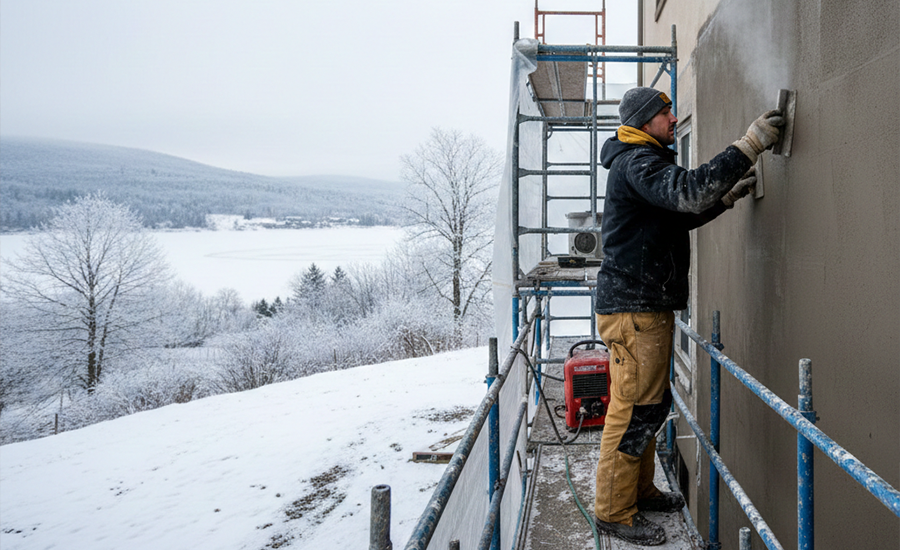The façade is basically the exterior of the building, which gives a substantial impact on the building’s architecture and durability. Be it a historic or modern building, every structure has its own kind of façade, which includes different designs and operations that fit your property so well. The engineering of the facade plays a crucial role in construction, as it enhances safety, durability, and improves the resale potential of residential and commercial properties. From glass curtain walls to traditional brickwork, façade systems vary widely depending on architectural goals, climate, and budget.
In this blog, we’ll be thoroughly discussing the role of façade work in architecture, types of facades, their functions, and limitations:
What is Façade Work?
The word façade is the French word meaning “face.” In construction, façade work carries out exterior functions of a building and comprises the following activities:
- It is to design the exterior appearance.
- It balances the appearance and stability of the building.
- It acts as a protective barrier against harsh weather conditions.
- It provides energy efficiency, air ventilation, and controls UV rays.
Significance of Façade System
Here are some of the fundamental aspects and purposes of installing a sound facade system:
Architectural Beauty
- Creates the identity of a building.
- Reflects the architectural vision.
- Helps structures stand out or blend with the surroundings.
Climate Shielding
- Protects the inside of the masonry from rain & unwanted residue.
- No risk of environmental & climatic damages.
We also explained how rainfall affects brick structures in what are the challenges of brick pointing during heavy rainfall?
Power Conservation
- Minimizes heat loss during winters and heat gain in summers.
- Works with insulation and ventilation systems to reduce energy consumption and associated costs.
For similar energy-saving benefits in masonry, check can brick pointing prevent frost damage in cold climates?
Healthy Indoor Conditions
- Protects against issues with bad air infiltration and water seepage.
- Promotes healthy air and controls pest infestation.
Structural Longevity
- Extends the lifespan of the building by acting as a protective barrier.
Varieties of Façade Systems
Let’s have a look at the vast variety of façade system that suits your property types:
| Façade category | Description |
|---|---|
| Glass curtain façade | It is made of glass and aluminium, commonly used in skyscrapers and office buildings. |
| Outer sheathing | It involves two materials for extra protection, like stone or metal, used in rental properties. |
| Prefabricated concrete façade | These are energy-efficient panels, installed in site areas or in industrial projects. |
| Brickwork exterior | It consists of masonry units, eg, bricks and stones, used in historic homes. |
| Air-cavity Façade | It is the dual cavity system, best for insulation. |
| Two-tier façade structure | Two glass structures are best for high-tech buildings |
Integral Role of Façade
A carefully engineered façade delivers such crucial operational functions.
- Climate moderation: It regulates the indoor temperature.
- Sunlight penetration: It helps in natural light penetration with insulation.
- Soundproofing: It cancels out the unwanted noise from the outside.
- Sealing performance: It perfectly seals your home and reduces drafts.
- Building Stability: It endures the environmental stress & seismic activities.
A related discussion on protecting Bronx properties can be found in why is brick pointing critical for protecting Bronx structures from water damage?

Complications in Façade Work
As façade work serves several functions, it also comes up with some shortcomings, including:
- Expensive Investment: Premium materials and engineering solutions are expensive.
- Upkeep Requirements: Glass, stone, and metal require regular upkeep.
- Complicated Assembly: Requires skilled labor and advanced technology.
- Weather Responsiveness: Work operations should be done according to the season & weather conditions.
For seasonal guidance, see our blog is summer or winter better for brick pointing projects?
Conclusion
In conclusion, façade work is not only done to enhance the structural appearance, but it also involves strengthening the building’s stability and improving its energy efficiency, which results in lower electricity consumption. Façade work consists of a variety of masonry units; choose wisely, ensuring it matches the stability and durability of your building.
Sardar Restoration Corp. proudly serves every corner of NYC, including the Bronx, Manhattan, Brooklyn, Westchester, and Queens. Our services are designed to meet your needs, providing top-quality solutions wherever you are. Check our service areas to see how we can assist you in your location.
Contact us today at (+1) 917-355-8556 or sardarrestoration@gmail.com, or visit us at 2770 Fish Ave, Bronx, NY 10469, United States.
FAQs
Do you handle all types of façade work, like glass, stone, and cladding?
Yes! Sardar Restoration Corp. handles all types of façade work, ensuring it complements your building type and fits your budget, including:
- Glass curtain walls
- Aluminum cladding
- Precast concrete
- Stone masonry
- Ventilated façades
Can you design a custom façade for my project?
Yes! Sardar Restoration Corp. custom-made design for your building façades, ensuring it matches your vision and the type of durability, design, and resilience you want.
Do you also repair or restore old façades?
Yes! Sardar Restoration Corp. offers installation of new façades and restoration and repairs of old façades. We make sure to regain the strength and architectural charm of your façade.
Do you ensure that façade systems are weather-resistant and energy-efficient?
Yes! Sardar Restoration Corp. only installs façade systems that can endure harsh weather conditions and provide insulation to your home, guaranteeing it reduces the consumption of energy.










